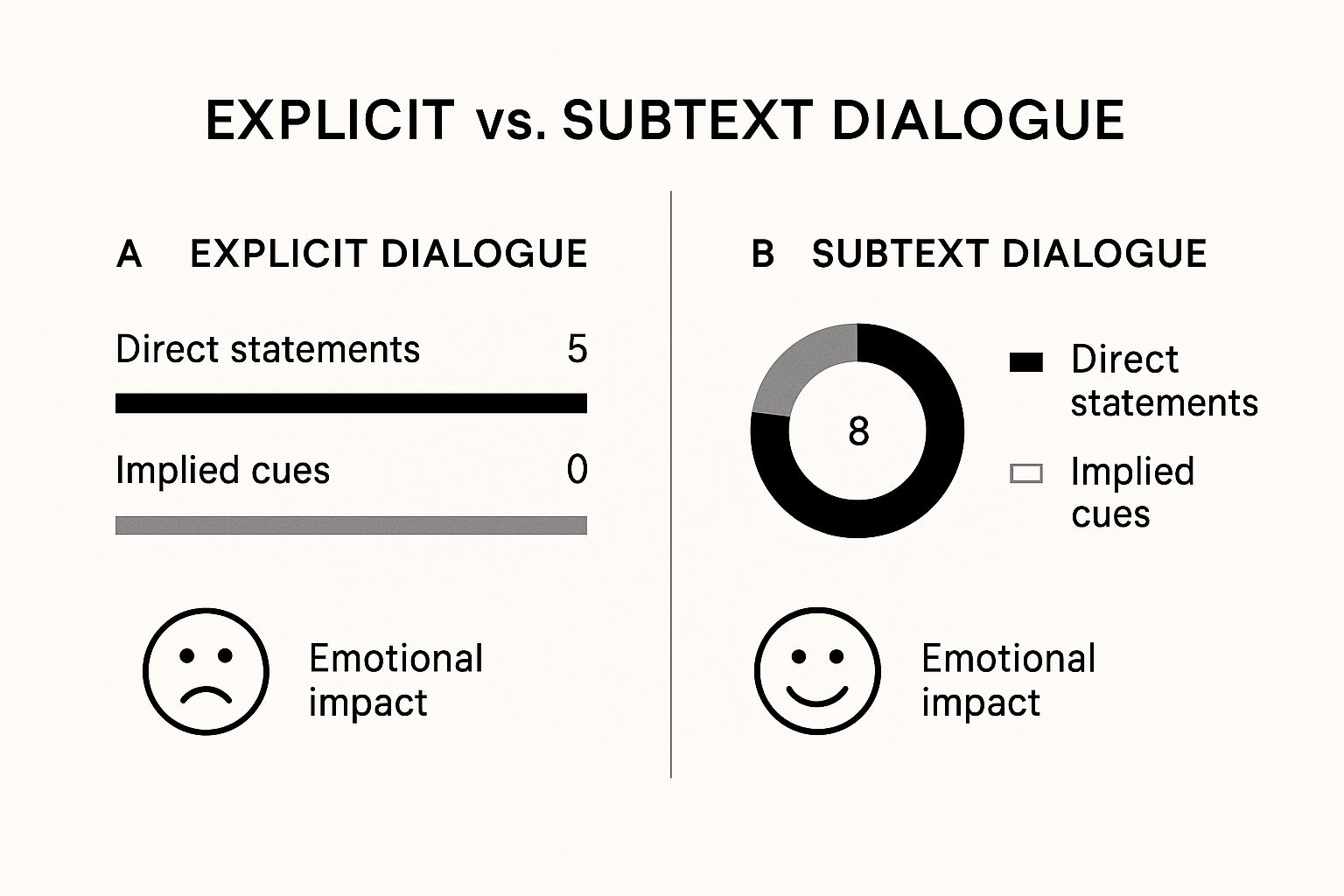Create Your Own AI Girlfriend 😈
Chat with AI Luvr's today or make your own! Receive images, audio messages, and much more! 🔥
4.5 stars

Writing great dialogue isn't just about putting words in your characters' mouths. It's about making them speak in a way that feels true to who they are, pushes the story forward, and sounds completely natural to the reader's ear. If you want to learn how to write dialogue that pulls people in, you need to make sure every single conversation matters.
Why Authentic Dialogue Is Your Story's Engine
 Dialogue is so much more than characters just talking. Think of it as the engine that powers your entire narrative. It doesn't matter if you're writing a novel, a screenplay, or an immersive roleplay scenario—getting the dialogue right is non-negotiable. Powerful conversations are the absolute lifeblood of any compelling story.
Dialogue is so much more than characters just talking. Think of it as the engine that powers your entire narrative. It doesn't matter if you're writing a novel, a screenplay, or an immersive roleplay scenario—getting the dialogue right is non-negotiable. Powerful conversations are the absolute lifeblood of any compelling story.
In my experience, dialogue is the sharpest tool in a writer's kit because it accomplishes several critical tasks at once:
- It Reveals Character: Dialogue is your best chance to show, not tell. A character's word choice, their unique speech patterns, and what they leave unsaid reveals everything. It’s the difference between telling us a character is sarcastic versus having them deliver a perfectly timed, cutting remark.
- It Builds Tension: Nothing creates suspense like a heated argument, a veiled threat, or a conversation heavy with unspoken feelings. This kind of back-and-forth can build emotional investment far more effectively than pages of description ever could.
- It Moves the Plot: Forget clunky exposition. Skilled writers use dialogue to introduce conflict, drop crucial clues, and force characters into making story-altering decisions.
The Foundation of Purposeful Conversation
Every line a character speaks must earn its place on the page. It’s a simple but powerful rule. Before you even start writing a scene, ask yourself: What is the point of this conversation? If it doesn't reveal something new about a character, build the atmosphere, or move the plot, it's probably just filler. Cut it. This ruthless approach keeps your story tight and your reader hooked.
Think about the last book you couldn't put down. I'd bet the moments that stuck with you were powerful exchanges between characters—the ones that made you feel something. That's what we're aiming for. It’s no surprise that literary analysis shows dialogue often makes up a massive portion of popular fiction, sometimes as much as 59 percent. This just confirms what readers want: immersive, character-driven stories where they experience events through conversation.
The true art of dialogue isn't just capturing how people talk; it's capturing the essence of a character and a moment in the fewest words possible. It’s about creating an illusion of reality, not a perfect transcription of it.
Dialogue must serve multiple purposes to be truly effective. Below is a quick breakdown of its core functions in any narrative.
Core Functions of Effective Dialogue
| Function | What It Achieves | Quick Tip |
|---|---|---|
| Characterization | Reveals personality, beliefs, and background through word choice and tone. | Let a character's vocabulary and sentence structure reflect their education and upbringing. |
| Plot Advancement | Introduces new information, conflict, or decisions that move the story forward. | Use a conversation to reveal a clue or force a character to make a choice. |
| Building Tension | Creates suspense, conflict, or emotional stakes between characters. | Subtext is your friend. What isn't said can be more powerful than what is. |
| Exposition | Delivers necessary background information to the reader in a natural way. | Weave backstory into a relevant argument or discussion, don't just "info-dump." |
Mastering these functions is what separates flat, boring scenes from ones that leap off the page and stay with the reader long after they're finished.
Making It Sound Real and Unique
Here’s a common trap: "realistic" dialogue does not mean you should transcribe real-life conversations. Trust me, real speech is messy, repetitive, and full of "ums" and "ahs." Fictional dialogue needs to be a cleaned-up, heightened version of reality—it has to sound real without being boring.
Even more important, every character needs a distinct voice. A world-weary detective isn't going to talk like an optimistic teenager, and their dialogue must reflect their unique experiences, education, and perspective. This is a core principle when designing AI companions, too; a unique voice is what defines the character and makes the interaction feel genuine. For anyone creating characters, exploring different persona tags can provide a great starting point.
Ultimately, great dialogue is the heart of your story, beating with the rhythm of conflict, personality, and pure human emotion.
Giving Each Character a Unique Voice
Here’s the real goal when you’re learning to write dialogue: craft conversations so distinct that your reader knows exactly who is speaking without a single dialogue tag in sight. This isn't just some fancy literary trick. It's the very soul of creating believable characters that jump off the page and feel like real people.
Think of a character's voice as their verbal fingerprint—a unique signature shaped by their entire life. A battle-hardened sergeant isn’t going to sound like a bubbly influencer. Their word choice, their rhythm, even the way they use silence will be worlds apart. A powerful, authentic voice isn't just about listing personality traits; it's about unearthing the why behind how they speak.
Digging into Your Character's Background
To get that unique voice, you have to become a bit of an archaeologist, sifting through the layers of your character's life. Their speech patterns are the artifacts they've collected along the way, and what you find will directly shape how they sound.
Start asking yourself some specific questions:
- Education and Class: What's their background? A high-school dropout's vocabulary is going to be different from a Ph.D.'s. Someone who grew up in a blue-collar neighborhood will use different slang and turns of phrase than someone from an affluent suburb.
- Profession: What do they do for a living? A lawyer’s language is often precise and structured, while a musician might speak in more abstract or metaphorical terms. Our jobs mold our daily conversations and ingrain certain habits.
- Geography: Where are they from? This is a goldmine. Regional dialects, local slang, and cultural touchstones add a rich layer of authenticity. A character from rural Texas will have a completely different cadence and vocabulary than someone born and raised in Boston.
This groundwork is absolutely essential. It’s the raw clay you'll use to sculpt a consistent and believable voice for your character.
The Building Blocks of a Unique Voice
Once you have a firm grip on your character's backstory, you can start translating those details into specific verbal traits. This is where you move from the abstract idea of a character to the concrete words they'll actually say.
Let’s get tactical and look at the key elements:
- Vocabulary: Does your character lean on simple, direct words, or do they prefer more academic or flowery language? Do they have a potty mouth, or are they more reserved?
- Sentence Structure: Are their sentences long and winding, or short and punchy? A character who’s nervous or unsure might speak in fragments, while a confident leader will use clear, declarative statements.
- Rhythm and Pace: How fast do they talk? A hyper, energetic person will have a rapid-fire delivery, completely unlike someone who is more thoughtful and deliberate. I always recommend reading your dialogue aloud to feel the cadence.
- Verbal Tics: This is the fun part. Does your character have a go-to phrase? A filler word like "y'know" or "like"? Do they trail off when they're uncomfortable? These little habits make a voice instantly recognizable.
A character’s voice is the melody of their personality. It’s not just what they say, but the entire musicality of how they say it—the rhythm, the pauses, the emotional undertones. When you get this right, your dialogue sings.
A cynical detective, for instance, might speak in short, clipped sentences, leaning heavily on dry humor and world-weary slang. In contrast, an idealistic young activist might use passionate, sometimes long-winded sentences filled with hopeful jargon. They’re built from the same blocks but assembled in completely different ways.
This same principle is vital when creating believable AI personas. You can even browse a library of AI characters to see firsthand how distinct backstories and personalities create truly unique conversational styles.
Bringing It All Together in Practice
So what does this look like on the page? Let’s imagine two characters reacting to a failed business venture.
Character A (The Veteran CEO): "The numbers are what they are. We misjudged the market. Liquidate the assets, cut our losses, and we move on. Emotion is a liability we can't afford."
Character B (The Idealistic Founder): "Move on? This was supposed to change things! We can't just... throw it all away. Not after one bad quarter. There has to be another way, something we’re missing."
Without any "he said" or "she said," you can already hear them, can't you? Character A is pragmatic, detached, and speaks in decisive commands. Character B is all emotion, speaking with a desperate energy punctuated by pauses and rhetorical questions. Their voices are a direct echo of their personalities, making the scene instantly more real and compelling. That's the power of a well-defined voice.
Using Dialogue to Drive the Plot

Every line of dialogue your characters speak needs to earn its keep. Seriously. If a conversation isn't doing some heavy lifting for the story, it's just dead weight, slowing the pace and, frankly, boring your reader. Let's get into the nuts and bolts of making your dialogue an active participant in your plot.
Think of dialogue as action. A sharp exchange can be just as explosive as a car chase. It can introduce a twist, drop a critical clue, or back a character into a corner they can't escape. It's the engine, not the window dressing. The real goal is to turn every conversation into a moment that matters.
Making Every Conversation Count
Dialogue is one of your best tools for revealing information without just dumping it on the page. Instead of a long, clunky paragraph detailing a character's tragic backstory, let it bleed out through a tense conversation with an old friend or a bitter rival. It's so much more compelling for the reader to piece things together.
Here are the main jobs your dialogue should be doing to push the story forward:
- Sparking Conflict: A simple chat can quickly unravel into a full-blown argument that changes everything. The tension should build through what's said—and what isn't.
- Revealing Information: This is where characters can share vital backstory or plot points, but it has to feel natural. They should be talking because they need to, not because the reader needs to know.
- Building Suspense: You can create incredible tension by hinting at secrets, dangers, or future events. Sometimes, a character's careful avoidance of a topic is more telling than anything they could say.
- Forcing a Decision: A powerful conversation can be the very thing that pushes a character to make a choice, sending them down a new path and kicking off the next stage of your plot.
Let's put this into practice. Instead of telling the reader, "The kingdom was on the brink of war," let the characters show it.
Imagine this scene: A weary general is giving a report to his young, untested queen.
General: "The grain stores won't last another month, Your Majesty. My scouts say their banners are gathering at the northern pass. They’ll march before the first snow."
Queen: "And our allies?"
General: "They send their sympathies. Not soldiers."
In three short lines, we've established immense stakes, revealed the fragile political landscape, and set up a massive, immediate conflict. No clunky narration required.
Weaving in Exposition Without the Dump
One of the surest signs of an amateur writer is the dreaded "info-dump." This is when characters stop sounding like people and turn into walking encyclopedias, telling each other things they obviously both already know, just so the reader can catch up.
The best way to sneak in exposition is to hide it inside a conflict. When people argue, they naturally bring up the past. They use information as a weapon, a shield, or a way to justify their actions.
A character might snap, "You think I can trust you after what happened in Lisbon?" That's a world away from the clunky, "As you know, ten years ago in Lisbon, you betrayed our team, which has led to our current state of mistrust." One feels real and creates intrigue; the other is a textbook info-dump.
This drive for natural, purposeful conversation isn't just a fiction-writing challenge. It's a huge focus in tech, too. The global chatbot market, valued at $2.47 billion in 2021, is expected to explode to $46.64 billion by 2029. This incredible growth is all about creating AI that can hold a conversation that feels authentic and gets something done—proof of how much we value dialogue that works. You can read more about the rise of conversational AI and see how these principles apply across industries.
The Power of Subtext
This is where things get really interesting. The most sophisticated way to drive your plot with dialogue is through subtext—the art of what's not being said. It’s the real meaning simmering just beneath the surface of the words.
Picture two business partners who can't stand each other talking about a new project.
Partner A: "I've had a look at your proposal. It's... ambitious."
Partner B: "I believe in aiming high. Some of us aren't content with mediocrity."
On the surface, it's a professional exchange. But the subtext is absolutely dripping with condescension, resentment, and a challenge. This unspoken battle is what drives the emotional core of the scene, creating rich layers of meaning and promising that things are going to get much, much worse. When you master subtext, your dialogue will be more than just functional; it'll be unforgettable.
Polishing Your Dialogue Like a Pro
A first draft is never the final word. When it comes to dialogue, the initial pass is really just about getting the ideas down. The real magic, the stuff that makes a conversation stick with a reader long after they’ve closed the book, happens in the edit. This is where you get to be ruthless, trimming the fat and polishing every line until it gleams.
If I can offer one piece of advice that has served me better than any other, it’s this: read every single line of dialogue out loud. Seriously. It's a non-negotiable step in my own process. What looks perfectly fine on the page can sound clunky, robotic, or just plain weird when spoken. This simple trick is the fastest way to find and fix unnatural rhythms and awkward phrasing.
Balancing Tags and Beats
Once you're sure your dialogue sounds like something a real person would say, it's time to look at how you're presenting it. You need to guide the reader, making it clear who's speaking without bogging them down. Your two main tools for this are dialogue tags and action beats. Knowing when to use each one is key to controlling the rhythm and feel of your scene.
- Dialogue Tags: These are the straightforward "he said" or "she whispered" attributions. Their job is purely functional—to identify the speaker. You want them to be nearly invisible, letting the reader focus on the conversation itself.
- Action Beats: This is where you show, not just tell. Instead of a tag, you use a descriptive sentence to show the character doing something as they speak. Action beats are power players. They can reveal a character’s inner emotional state, ground the scene in a physical setting, and slow the pacing for dramatic effect.
Fast-paced, back-and-forth banter? Simple tags (or even no tags) work best to keep the energy up. Want to ramp up the tension or show a character's hesitation? An action beat will do that work for you.
An action beat can turn a simple line into a cinematic moment. "I know," she said, is functional. But this? "I know." She refused to meet his gaze, tracing the condensation on her glass instead. That tells a story.
Let's break down the difference.
Dialogue Tags vs Action Beats
The choice between a simple tag and a descriptive beat can completely change the texture of your scene. Here's a quick comparison to help you decide which tool to reach for.
| Element | Purpose | When to Use | Example |
|---|---|---|---|
| Dialogue Tag | Clarifies the speaker quickly and efficiently. | In fast-paced conversations or when speaker clarity is the only goal. | "Let's go," he said. |
| Action Beat | Grounds the scene, reveals character, and controls pacing. | To add emotional depth, show a character's state of mind, or slow down a key moment. | He slammed the folder on the desk. "We're done here." |
Finding the right balance is what keeps your scenes from feeling like a disembodied script. It prevents that dreaded "talking heads" syndrome, where characters just float in a white void, spouting lines at each other.
The Power of Subtext and Silence
Often, the most compelling dialogue isn't about what's said, but what's left unsaid. That's subtext—the true meaning simmering just below the surface of the words. It’s the gap between what your character says and what they actually feel or mean. This is how you create rich, layered interactions that feel true to life.
People rarely say exactly what they're thinking, especially during moments of high stress, vulnerability, or conflict. We use sarcasm, feigned politeness, and clever evasions to communicate. Mastering subtext is the final step in moving beyond clunky, on-the-nose conversations where characters do little more than state the obvious.
This visual shows just how much emotional weight subtext can add.

As you can see, the shift from explicit statements to implied meaning creates a much bigger emotional payoff for the reader.
Equally powerful is the deliberate use of silence. A pause, an interruption, or a flat-out refusal to speak can be incredibly dramatic. These moments of quiet build tension and give incredible weight to the words that eventually follow—or they highlight the importance of the silence itself. Use ellipses (...) or an action beat describing the pause to let those unspoken feelings hang in the air.
Think about it: a character who meets a direct question with a long, heavy silence says far more than a paragraph of defensive explanation ever could. It creates suspense and signals to the reader that the stakes have just been raised.
Common Dialogue Mistakes You Can Easily Fix
Even the most experienced writers stumble into dialogue traps. It happens to all of us. Think of this section as your go-to troubleshooting guide for spotting and fixing those subtle issues that can pull a reader right out of the story.
Learning to recognize these common offenders is the first step. Once you see them, you can make simple tweaks that transform clunky conversations into something far more powerful and authentic.
The Problem of On-The-Nose Dialogue
This is easily the most common pitfall. On-the-nose dialogue is when characters state exactly what they're thinking and feeling, leaving nothing to the imagination. It’s blunt, feels robotic, and frankly, doesn't trust the reader to connect the dots.
In real life, people rarely speak with such raw, unfiltered honesty. We hint. We deflect. We talk around our true feelings. Your characters' dialogue should have that same messy, human complexity.
- Before (On-the-Nose): "I'm so angry with you because you forgot our anniversary. It makes me feel like you don't care about our relationship."
- After (Subtle and Realistic): "I waited for you. Did you even look at the calendar this morning?"
See the difference? The "after" version crackles with unsaid emotion. The question is a clear accusation, and the simple phrase "I waited for you" speaks volumes about hurt and disappointment without spoon-feeding it to the reader.
Clumsy Exposition Dumps
Ah, the dreaded exposition dump. This is when you force characters to tell each other things they obviously already know, just so the reader can catch up on backstory or world-building. It’s a shortcut that immediately shatters the illusion of a real conversation.
The rule of thumb is simple: if the only reason a character is saying something is to inform the reader, you need to find another way. Weave exposition into conflict or action instead.
For instance, don't have two veteran scientists explain a core concept to each other. Instead, have one explain it to a new, struggling intern. This creates a natural reason for the information to be shared and builds character at the same time. The need for clear, functional dialogue isn't just a creative concern; it's a massive commercial one. The market for conversational systems is projected to soar from $7.90 billion in 2024 to $89.76 billion by 2033, a boom fueled by the demand for AI that can communicate complex information effectively. You can discover more insights about the conversational systems market to see just how critical precise dialogue has become in the tech world.
When Everyone Sounds the Same
Does your grizzled, hard-boiled detective use the same words and sentence patterns as the cheerful barista he’s interviewing? If so, you’ve got a case of "same-voice syndrome." This happens when the author's own voice bleeds into every character, making them all sound like slightly different versions of the same person.
As we covered earlier, every character deserves a unique verbal fingerprint shaped by their background, personality, and life experiences.
Try this quick diagnostic test:
- Open a page of your manuscript with a lot of back-and-forth dialogue.
- Delete all the dialogue tags ("he said," "she asked").
- Read the conversation aloud. Can you tell who is speaking just from their word choice and rhythm?
If you can't, it's a sign you need to go back and give each character a more distinct voice.
Getting Realism Right (Without the Filler)
In an effort to sound "realistic," many writers overload their dialogue with filler words—the "ums," "ahs," "likes," and "you knows" that pepper real-life speech. While people do talk like this, seeing it on the page is often just distracting and kills the story's momentum.
Remember, your goal isn't a perfect transcript of reality. It's the illusion of reality.
A few well-placed filler words can effectively show a character is hesitant, nervous, or searching for the right words. But a little goes a long way.
- Before (Cluttered): "Well, um, I was, like, thinking that maybe we should, you know, go to the other location?"
- After (Clean and Effective): "I was thinking... maybe we should go to the other location."
The second version achieves the exact same effect—conveying hesitation—with a simple ellipsis. It’s cleaner, punchier, and much more respectful of the reader's attention.
Your Questions About Dialogue Answered

Let's dive into some of the most common—and often nagging—questions I see writers struggle with when it comes to dialogue. Getting conversations right on the page is about more than just having a good ear; it involves a handful of technical and stylistic choices that can make or break a scene.
This is your go-to guide for those moments you get stuck. I'll give you direct, practical answers to help you clear those common hurdles and get back to writing.
How Should I Format Dialogue in a Novel?
Proper formatting is your dialogue's invisible scaffolding. When it's done right, no one notices it. When it's wrong, it can yank a reader right out of your story. The good news is the rules are simple and quickly become second nature.
The industry standard is all about clarity:
- A new speaker gets a new paragraph. This is the big one. Every single time the person talking changes, hit that enter key. It's a powerful visual cue for the reader.
- Use double quotation marks (" ") to wrap everything that's spoken aloud.
- Punctuation goes inside the quotation marks. Whether it's a comma, a period, or a question mark, it almost always gets tucked inside the closing quote.
Here’s what that looks like in practice:
"I'm not sure that's a good idea," she said.
"Why not?" he asked. "We've run out of other options."
Nailing this is a small detail that signals professionalism and, more importantly, shows you respect the reader's time and attention.
Should I Write Character Accents Phonetically?
This question comes up all the time, and my answer is almost always a firm no. It seems like a great way to convey a character's background, but writing accents phonetically often does more harm than good. It slows the reader down, can be genuinely difficult to decipher, and—worst of all—can easily slip into caricature.
So what's the alternative? Instead of butchering your spelling, try these far more effective techniques:
- Word Choice (Diction): Does your character use regional slang? Do they have a unique vocabulary that hints at where they're from?
- Sentence Structure (Syntax): Capture the rhythm and cadence of a dialect. Think about sentence length and construction. Are their sentences long and lyrical or short and punchy?
- A Light Touch: Sometimes, a single, well-placed word or phrase that’s unique to a region is far more powerful than a paragraph of misspelled words.
The goal is to suggest an accent, not transcribe it. Trust your reader to fill in the blanks. A little goes a long way.
How Much Small Talk Should Be in My Story?
Very, very little. Maybe none. Real-life conversations are cluttered with "hellos," "how are yous," and other pleasantries, but fictional dialogue needs to work harder. Every line spoken should be doing a job—revealing character, moving the plot forward, or building tension.
Cut the fluff. Resist the urge to include every greeting and goodbye unless its presence (or absence) is significant. A character refusing to say goodbye carries weight; a standard one rarely does.
Think of your page count as precious real estate. Don't waste it on chatter that goes nowhere. Get straight to the conflict, the emotion, or the critical information.
What’s the Difference Between Subtext and Being Vague?
Understanding this distinction is a game-changer for writing sharp, layered dialogue. While both involve unstated meaning, their impact is completely different.
Subtext is the art of implying a character's true meaning without stating it directly. It works because you've given the reader enough context to understand the hidden message. This creates depth and makes the reader feel smart for "getting it."
Vagueness, on the other hand, is just unclear writing. The character's words are confusing, and there are no clues to help the reader figure it out. This doesn't build tension; it builds frustration.
The key to powerful subtext is ensuring the surrounding action, character history, and scene setup provide the necessary clues. If you're looking for more ways to create richer character interactions and explore complex emotional scenarios, you might find some great ideas on the https://www.luvr.ai/blog.
Crafting compelling conversations is at the heart of what we do. At Luvr AI, we focus on creating AI characters with distinct voices and personalities, allowing you to immerse yourself in rich, dynamic roleplay scenarios. Experience the next level of interactive storytelling and design your perfect conversational partner. Explore Luvr AI today!



